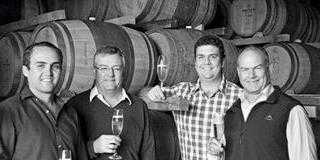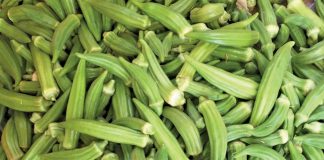Frik and Issie van Sittert liveon the farm Paardeplaats, some 18km from Hartbeesfontein in the North West. Frik has devotes some 380ha to the production of maize and sunflowers, and has a flock of 50 ewes and a ram which produce lambs for slaughter. He is also chairperson of the informal Ottosdal No-Till Club, whose 20-odd members from surrounding districts meet twice to three times a year and keep in touch year-round to share no-till experiences.
This network is vital, as farmers who want to adopt or practise no-till, or other aspects of conservation agriculture (CA), have little access to information in South Africa. When they appeared in the Farmer’s Weekly of 2 September 2007, Frik and his father Dirk had been practising no-till for five years. It all begun after they’d bought new conventional tillage equipment, which disturbed the soil minimally, and had applied glyphosate herbicide to control kweek grass on a new farm they’d bought.
In the meantime, they heard about a no-till study tour that Johannes Smith, a local Omnia agronomist, had made to Australia with Chris Roode, a farmer from Lichtenburg who then adopted no-till in September 2001.Frik visited Chris’s farm and, having studied soil structures for his BSc Agric at the University of the Free State, he had a firm grasp of soil’s dynamics and what changes its structure. He quickly grasped the benefits of no-till.
A new rotation regime
“As in 2007, I still plant 380ha of dry arable land in 90cm row widths,” said Frik. “But instead of planting maize for two seasons and sunflower in the third, I now plant about 220ha to maize and 160ha to sunflower in a rotation system. This allows maize residue to build up and reduces disease transmission. “As I planned in 2007, I’ve cut my maize plantings to 15 000 plants/ha instead of 18 000 plants/ha, because the new Roundup Ready variety I plant produces two cobs per plant.
In spite of the lower population, my yields are up. In 2007 I was averaging 3t/ha to 4t/ha, but the season before last I harvested 4,7t/ha and this past season I averaged 5t/ha.“I’ve also marginally reduced my sunflower plantings to 35 000 plants/ha from 36 000 plants/ha. While my sunflower yield has improved to 1,5t/ha I believe that this could be better – at the moment I’m battling to control weeds as no Roundup Ready variety is available. I’ll be attacking this problem through a combination of new herbicides that recently became available and mechanically protecting the plants during sprayings.”
Earthworms return
Frik’s soil quality has improved vastly. Organic matter keeps increasing and microbial activity has returned, thanks to steadily accumulating residue cover. Better water infiltration decreased soil erosion dramatically. Gullies are filling up and sheet erosion has diminished so much that Frik’s combine and new self-propelled sprayer now travel smoothly over the lands. Thanks to water infiltration, residue cover and cutting off of maize stalks roughly 20cm to 30cm above ground level when harvesting, the excess rainfall that does flow off the lands is clear, free of any soil.
The height of the stalks act as a buffer, slowing down excess rainfall so that it can infiltrate the soil. It also minimises wind erosion. Residue cover has now increased so much that Frik has had to fit star-wheeled, V-shaped residue manager attachments to brush it aside from the path of the planting coulter. This lets him plant directly into the soil at even depth and allows in sunlight to ensure good germination.
“But the thing I’m most excited about is that earthworms are returning,” says Frik. “This is clear evidence my soils are returning to what they were before they were systematically destroyed by conventional tillage practices. What makes me ecstatic is that every no-till doubting Thomas in the district and beyond said that earthworms would never return to my lands.”
Fruits of no-till
Frik says his objective each year is to generate a net profit, between direct input costs and realisable grain prices of R2 000/ha. For the last three years he has managed to accomplish this. His target equates to about 30% to 40% profit on direct input costs, thanks to the lower input costs of no-till compared to conventional tillage practices, and increased yields.
For example, Frik says that the 142kW New Holland TM 190 he bought five years ago to pull his Jumil 2980 PD Exacta eight-row no-till planter has only done 600 hours. He reckons that at this rate it will last him another 30 years. Frik estimates his fuel usage at 4â„“/ha for planting; for spraying, 1â„“/ha per application x five applications, or 5â„“/ha, and for harvesting and transport to his local silo, 10â„“/ha to 12â„“/ha.
Since he’s farming profitably and determined to improve his crop production and soil enhancement even further, Firk has him invested heavily in new no-till equipment. He recently bought a self-propelled John Deere 4730 183kW state-of-the-art sprayer, and a new Jumil Lider 10500 TTD lime spreader. He also recently bought a used Claas Mega 208 self-propelled combine, and equipped it with a new Geringhoff Mais-Star-MS eight-row maize header.
Frik says that this equipment could let him expand by another 200ha, but that he isn’t going to chase hectares by neglecting to practice no-till as it should be. Frik is surprised that so few farmers are adopting no-till as all the equipment is now readily available in South Africa. He invites farmers committed to going this route to contact him and other no-till practitioners for advice – the system takes take trial, error, time and a high level of management, but it works.
Frik doesn’t believe he has made any mistakes during his eight years of no-till, and says his biggest success is having money in the bank and an investment in his soil. Every year he is improving his soils for his own, his children’s and their children’s benefit.
Call Frik van Sittert on 083 400 3314, or e-mail [email protected].













